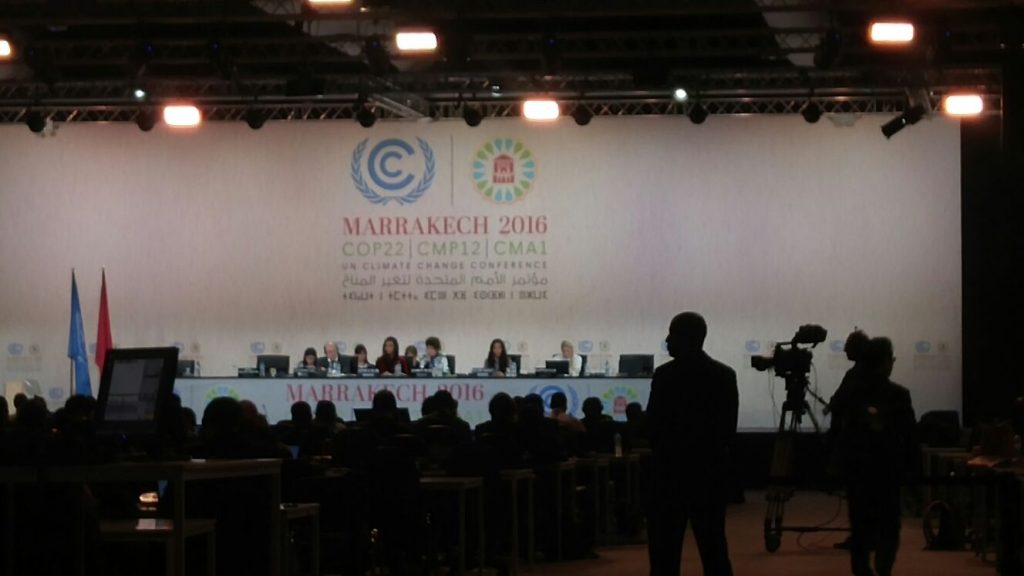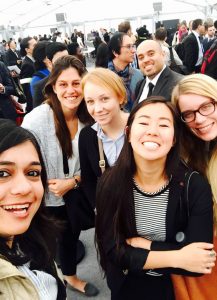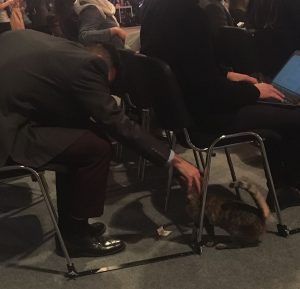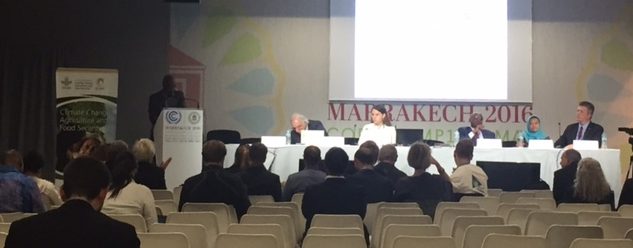Today marked the opening of COP-22 in Marrakech, the start of the “Implementation COP”. Things got rolling (delayed by an hour, in true UNFCCC form) with the COP opening plenary, featuring welcome statements from COP leadership including the COP 21 President, COP 22 President, and mayor of Marrakech, among others. There was a bit of a hold-up when Turkey, with the support of France and others, wanted to add an agenda item to the COP to allow discussion of its ability to receive climate finance (currently, Turkey is listed as a “developed” country, and the Paris Agreement states that climate finance is meant to support developing countries). The session was paused to allow for the COP President to confer with the related parties, and eventually Turkey was promised further consultations and the agenda was approved.

The first APA meeting was also held today, which is a continuation of the negotiating meetings that led to the Paris Agreement last December. During the APA plenary we heard updates from each negotiating block hinting at their priorities for the rest of the APA negotiations this week. The APA is tasked with specifying the “Paris Agreement Rulebook” which will clarify the specific details of how the Paris Agreement will move forward. Specifically, the APA is tasked with determining the form of future NDCs (country mitigation commitments), Adaptation Communications, the Compliance Mechanisms, a Transparency Framework, and specifying the details of the Global Stocktake. There was a strong sentiment among parties that the co-chairs should continue APA negotiations into next week, instead of shifting the discussion to the CMA as planned. The CMA represents all of the parties that have ratified the Paris Agreement thus far, and its first session needs to be during this COP because the Paris Agreement came into force last Friday. However, its very quick entry into force happened before several countries could complete their domestic ratification processes, so they will not be able to participate in CMA 1 here at COP-22. Because it is desirable for all parties to be involved in the negotiations on the Paris Rulebook, it is preferrable that CMA 1 be mostly just ceremonial, with the real negotiations continuing in the APA.
We’ll see how all that jargon plays out over the course of the week. But for now, here are your Day 1 updates from our excellent Week 1 crew!

(From L-R) Tanya, Delfina, Emily, Jade, and Megan waiting for our badges on Day 1
Megan: Opening day of COP 22 was a bit of a chaotic flurry. I started the morning off at the opening plenary session before heading to a side event and then meeting with my client, Climate Analytics, for the first time. The side event addressed loss and damage and brought up the interesting idea of forecast based financing- to allow at risk populations access to funding before a climate event to minimize damage. Following this, we attended the APA plenary session (and so did this lovely kitten who boosted everyone’s spirit after a long day).

Jade: Today, I attended a side event for my focus area, agriculture. Five country perspectives were given on monitoring, reporting, and verifying (MRV) emissions for the livestock sector and how mitigation efforts have been measured through this effort.

Tanya: On the first day of COP22, I started the day by watching the COP plenary via live stream, where the interesting issue of amending the agenda was raised by Turkey, due to their special circumstances in regards to a need for climate finance. This lead to the first informal break-out to discuss whether the COP could be opened until this issue was resolved. Thankfully, Turkey accepted that this be discussed tomorrow (Nov 8, 2016) and the COP was officially declared open!
After lunch, I attended three different side events – the first focused on the Philippines’ vision for integrating their mitigation and adaptation plans over the next 25 years, the second on inclusive loss and damage frameworks and its different conceptions and the last on INDC implementation and how to bridge the gap between research and practice.
At the L&D event, I noticed a shift away from a focus on attribution and towards a “humanitarian” perspective – for example, the very real existential threat to low-lying islands and coastal nations like Bangladesh was recognized as a serious issue, no matter who was responsible, and whether or not all of the damage could be attributed to climate change. At the INDC event I attended, two interesting issues were raised – what “ambition” means (and should mean) for different countries, and how to reconcile the need for informed policy with the pushback from national governments, due to a lack of political will. All in all, it was a super-informative day where I got to deep dive into these issues, even if some of the technical aspects of the discussions did go over my head!
Delfina: I started my morning by working with my client, ConexionCOP in the COP22 Plenary Opening Session. It was somewhat of a hectic process but with the help of the Duke team I was able to complete the task with no problem. Part of my client agenda was to attend the Opening Plenary Session for the APA. There I paid close attention to the LatAm perspective of the Implementation of APA. Following Plenary Session, I was able to catch the last part of a side event about Financing adaptation and risk modelling from a private actor perspective. Mr. Tippmann from the German Emissions Trading Association gave a very interesting pitch on commercial attractiveness of adaptation mechanisms for the private sector.